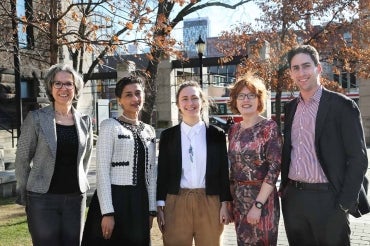Green infrastructure: New tool by U of T researchers to help construction industry reduce carbon footprint

Published: December 11, 2017
A team of researchers from the University of Toronto is partnering with the construction industry to help reduce the carbon footprint of buildings, bridges, public transit and other major infrastructure projects.
“What we’re building is a decision-support tool that can be used in the early stages of design and planning,” says Heather MacLean, a professor in the department of civil engineering who is one of five Faculty of Applied Science & Engineering professors involved in the project. “Ultimately, the goal is to produce infrastructure with much lower greenhouse gas impact.”
While green building certification programs have existed for decades, MacLean and her collaborators – including Brenda McCabe and Daman Panesar, professors of civil engineering, and Daniel Posen and Shoshanna Saxe, assistant professors of civil engineering – point out that these are typically considered only toward the end of the design process, when most major decisions have already been made.
“The decisions that have the most impact are the ones that are made early in the process,” says Saxe, who specializes in analysis of transit infrastructure. “These include how big it’s going to be, or what materials it will be made of. Once those are set, it really puts limits on how low the overall emissions can get.”
Nearly a year ago, the team was approached by EllisDon, a major construction and building services company headquartered in Mississauga. As part of its carbon impact initiative, the company and its partners, including BASF and WSP, are collaborating on projects that aim to elevate efficiency and sustainability in the built environment.
In their early talks, the researchers and industry partners quickly identified science-based decision support in the early stages of project planning as a key strategy for emissions reduction. They plan to analyze data from previously constructed projects and publicly available databases to generate predictive digital tools.
“Large-scale infrastructure projects are complex, consisting of many different construction activities, along with associated inputs of material and energy,” says MacLean. “We don’t yet have good data about the on-site and supply-chain emissions associated with these inputs, especially those specific to the Ontario context. If we can cut down on that uncertainty, it will greatly help inform these types of decisions.”
Read CBC report on massive green construction projects, featuring U of T Scarborough residence
Ontario's Ministry of Research, Innovation and Science announced last week that the project was among those that received funding through the TargetGHG program, administered by Ontario Centres of Excellence, which supports industry-academic collaborations that will help the province meet more aggressive future GHG targets.
“Supporting the efforts of large industries in their quest to reduce their greenhouse gas emissions is an important part of our government’s Climate Change Action Plan,” says Reza Moridi, minister of research, innovation and science. “With the help of our province’s innovative clean-tech companies, the TargetGHG program will help build a prosperous, low carbon economy and create a cleaner, more sustainable future for Ontario.”
In total, the project has attracted more than $2 million in funding from a variety of sources, including the Natural Sciences and Engineering Research Council of Canada (NSERC) as well as financial and in-kind contributions from the industrial partners.
“Taking steps to reduce the impacts of greenhouse gases and air pollution on our climate and environment is a key priority in Canada,” says Marc Fortin, vice-president, research partnerships at the Natural Sciences and Engineering Research Council of Canada. “NSERC is proud to partner with Ontario Centres of Excellence to connect Canada’s top researchers and companies to develop innovative clean technologies that will advance environmental sustainability in Canada and improve the health and quality of life of Canadians.”
“This project is a wonderful example of how our researchers leverage strong collaborations with industry to develop next-generation solutions to society’s most pressing challenges, including climate change,” said Ramin Farnood, vice-dean, research at U of T's Faculty of Applied Science & Engineering. “This tool has great potential to enhance the sustainability of major infrastructure not just here in Ontario, but around the world.”
A second U of T Engineering project, focused on installation and testing of fast-charging stations for electric vehicles, also received funding through the TargetGHG program. Led by Professor Reza Iravani, it will be carried out in collaboration with energy storage company eCAMION.
MacLean and her team are already looking to recruit the graduate students and postdoctoral fellows who will collect and analyze the data, and continue to work closely with their industrial partners as they move forward.
“It’s exciting to be working with partners that are eager to roll out solutions,” says Posen. “We have had great meetings, and we have a strong sense they are looking to turn this research into practical results.”



